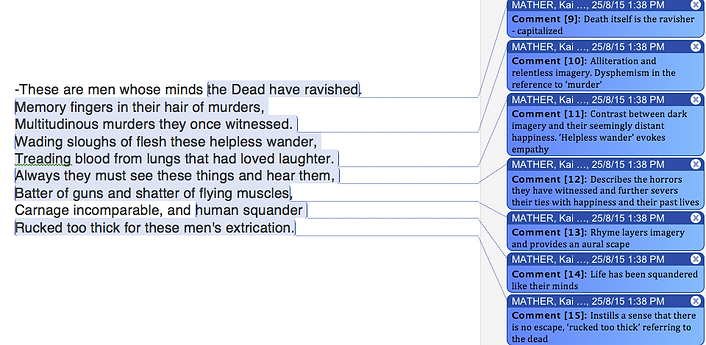
Annotation




Owen employs imagery and metaphor to deliver a powerful, morbid depiction of World War One.
Written in 1918 and told from the perspective of a veteran, ‘mental cases’ explores the spiritual, emotional, and mental damage caused by war. Owen continues to challenge the glorious and brave archetype of the soldier at that time, as he did in 'Dulce et decorum est'.
There is an abundance of imagery relating to hell and death. The former being where they are, and the later being where they wanted to be. The mental scarring and shock caused by the ‘rucked’ dead scattering the ground created a fear of death as much as it did a fear of the enemy.
In several lines Owen contrasts and compares the soldiers to skeletons and corpses to reflect their mental state and foreshadow their imminent death.
Visceral imagery is used throughout the piece to emphasize the gore and pain endured in the trenches. Mud and grit infiltrated wounds, and the dead remains of soldiers were then claimed by the mud and grit.
The macabre, symbolic descriptions of the gore also depict the soldier’s view of the battle.
The rhetorical questions in the first stanza also work to capture the reader’s attention and create a thought process early on in the poem.
Tactile:
When in the right headspace many lines evoke feelings powerful enough to give insight into the pain of the trenches. Words such as 'Wading' and 'Gouged' create a connection to other pains and experiences.
Aural:
Owen doesn't create as vivid an aural scape as he does visual and tactile. 'Batter of guns and shatter of flying muscles' is about the extent of the sounds in the piece.
Visual:
The brunt of the imagery in 'mental cases' is visual. You can see the gaunt faces of the soldiers and you can see them wandering the trenches in despair. Owen's unique and powerful use of visceral, visual imagery led to the poem's fame.
Olfactory:
Least used of all is the imagery pertaining to what horrible odors Owen and others smelled in the trenches. In some of the more graphic, visceral imagery, the smell of blood becomes more apparent.

<--- Download document
